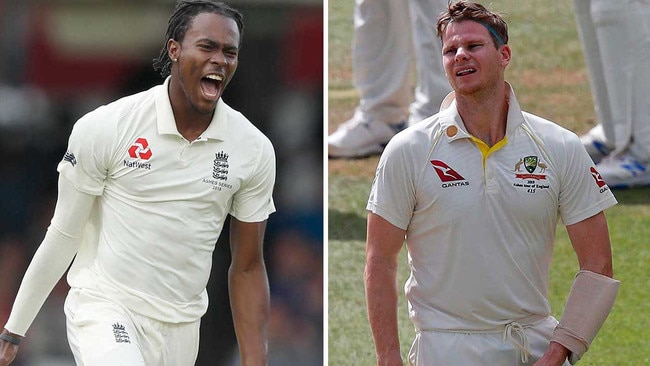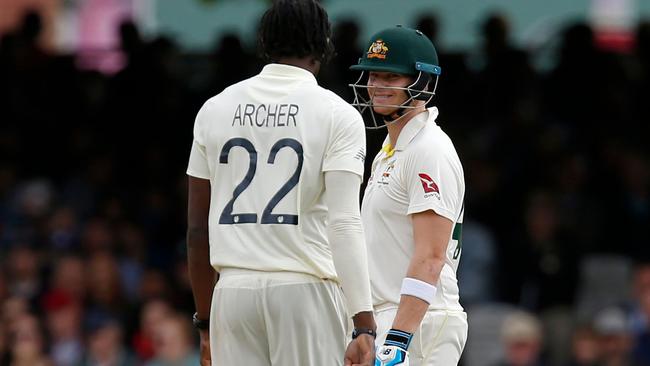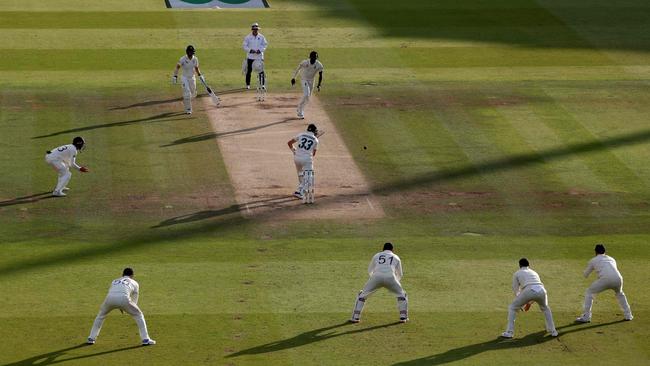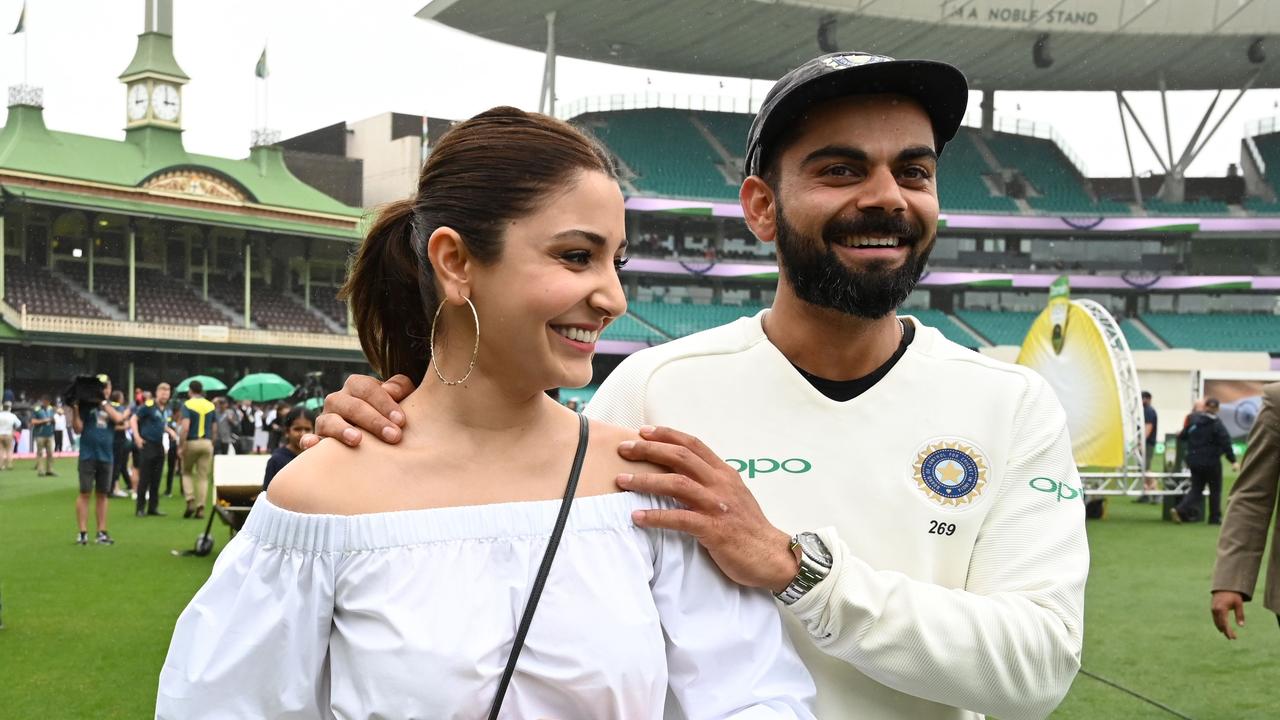
It was prescient, perhaps, to conclude a preview to the Lord’s Test with a quote from Mike Tyson ("Everyone has a plan until they get punched in the mouth").
The sight of Steve Smith, poleaxed on the pitch on the fourth afternoon, recalled the end of a boxing contest rather than a cricket match and Australia’s plans in this series have been thrown into disarray by Jofra Archer. After one match, Archer has become the most valuable member of the England team and has served notice that the Ashes are still up for grabs.
No debut has been anticipated more and no England debutant has made such a startling introduction to Test cricket in recent times than Archer has done here. Having produced some kryptonite to disarm Australia’s superman in the first innings, he set about the rest of Australia’s batting in the second, including Smith’s concussion replacement, Marnus Labuschagne, who was felled second ball by a bouncer as vicious as the one that did for Smith — a first-ball greeting, of similar nature, was called a wide by the umpire.
MORE: Aussies hold on for dramatic draw | Smith’s replacement saves the day | Groggy star in doubt for third Test
Given that, and given he was coming into the match cold, Labuschagne showed tremendous character, courage and composure to bat for more than two hours for a half-century and, along with Travis Head, who batted for a similar time, to take his team to the verge of safety. It was not Archer who kept the match filled with uncertainty as time ticked away, rather a disputable call from the third umpire, who decided that a catch had carried to Joe Root at mid-wicket — via the thigh of Jos Buttler at short leg — when there was enough evidence to suggest otherwise.
There were 12 overs remaining when Labuschagne was out, with England requiring six more wickets to win and although the tension was, at times, almost unbearable for the capacity fifth-day crowd, Australia lost only two more wickets before another great day’s Test cricket ended in gloom and, shortly afterwards, pouring rain. As it ended, so it began, with the loss of ten overs at the start of the day ultimately damaging England’s prospects.
There was an arresting image on the fourth day, taken from above by the “Spidercam” used by television nowadays. It showed Smith, moments after he had turned over, face down to face up, and it reminded me of the famous photograph of Cleveland Williams, taken from the rafters of the Astrodome in Houston, shortly after Williams had been knocked out by Muhammad Ali in 1966. If England were unable to land the knockout blow on the final afternoon here, the change in mood from Edgbaston is undeniable. They will approach the rest of the series with renewed confidence.
The delayed effects on Smith from that blow, which were registered on the fifth morning by the Australia team doctor Richard Saw, were those that battered boxers would recognise on the morning after: they included dizziness, drowsiness and “feeling in a fog”. This delayed concussion, rendering Smith unavailable and bringing Labuschagne immediate fame as the first concussion substitute in international cricket, heralded a dramatic psychological shift in the Test and the series.
At the start of play, the draw was favoured, an Australia win the second favourite. Their victory at Edgbaston had pushed them into favouritism for the series too. From the moment the news about Smith emerged, which renders him doubtful for the third Test at Headingley, the odds shifted — for the match and the Ashes. An England win in either or both, suddenly, seemed possible, a change that was evidenced from the field set for the first ball of the day, which included three fielders on the boundary, despite Australia’s position of strength.

Despite the precarious situation, England lost only one wicket in hauling themselves into a position from which they could contemplate victory and, promoted to No 5, Ben Stokes played an innings of great versatility to bring up his seventh Test hundred, his second at Lord’s and against Australia. Although he needed good fortune on the fourth evening, being dropped at slip and escaping a leg-before shout that Australia neglected to review off Nathan Lyon, he needed no such help on the fifth day. Watchful at first before accelerating after lunch, he played superbly.
A brace of swept sixes into the Mound Stand signalled the beginning of the charge and for a while, as England added 101 in 17 overs, we were back in one-day mode, remembering Stokes’s role a month ago in the World Cup final, as he targeted the leg side and ran feverishly between the wickets. The second half of his innings came twice as quickly as his first — 106 balls for 50, a further 54 for his hundred — which meant that Joe Root was able to declare with 48 overs remaining, the target 267 — a perfectly judged call.
The crowd soon sensed something dramatic was to come during a fast and furious four-over opening burst from Archer as he removed David Warner and Usman Khawaja, the former beaten from round the wicket again for his fourth consecutive single-figure score. As Root orchestrated the crowd from slip, encouraging them to get behind his team, there was Archer-inspired electricity running through the ground, which crackled when Khawaja was beaten on the outside edge. Labuschagne appeared to a furious welcome that was a far cry from the pleasant Division Two cricket he had been enjoying at Glamorgan.

Archer changed ends soon afterwards and gradually the hurricane blew itself out — Root will need to ensure he does not overuse him — and although Cameron Bancroft was beaten by a grubber from Jack Leach shortly after tea, Labuschagne and Head weathered the storm. It could have been different had Jason Roy caught a straightforward catch at second slip off Head — Stokes the bowler — with 20 overs remaining but having survived that, Head marshalled the lower order through the tense finale after Labuschagne had fallen to Leach.
Archer returned to fire bullets again from the Pavilion End and he hit Matthew Wade on the head first ball and rapped Tim Paine a painful blow on the forearm, after Leach had induced a gloved catch to short leg from Wade. Rather than stand there like a punch bag and take blows, Paine took on Archer’s short ball, which brought a stunning one-handed catch at square leg by Joe Denly. With seven overs remaining, the light fading and rain threatening, Australia were six wickets down and staggering, if not punch-drunk then close to it, so many blows had they taken from Archer.
There were four overs left when the umpires determined that the light was insufficient for a bowler of Archer’s pace. Head and Pat Cummins played out the remaining overs from Leach and Denly with great composure. There was a sharp missed chance at silly point by Rory Burns, with three overs left, as Cummins propped forward to Leach but Australia held firm.
The dramatic end notwithstanding, the centrepiece of the match was the stunning duel between Archer and Smith, which may yet have telling implications for the rest of this series and beyond. At 24, Archer will be in his prime for a good while yet, injuries and overuse aside, and at 30, Smith has time yet in his prime before his eyesight may start to impact on his unique technique. Whether it comes next week at Headingley or not, the game has a new rivalry to enthral us.
The Times



